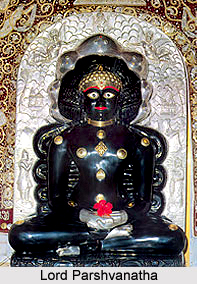 Shri Darbhavati Teerth located Gujarat is Jain pilgrimage centre. The teerth kshetra is situated in Mohalla of Dabhoi. The temple is dedicated to Lord Parshvanatha, the twenty-fourth Jain Tirthankara.
Shri Darbhavati Teerth located Gujarat is Jain pilgrimage centre. The teerth kshetra is situated in Mohalla of Dabhoi. The temple is dedicated to Lord Parshvanatha, the twenty-fourth Jain Tirthankara.
History of Shri Darbhavati Teerth
According to history Shri Darbhavati Teerth dates back to the ancient times. Sheth Shri Tejpal built a fort here and also got constructed a Jain temple. However, the image of Lord Parshvanatha remained submerged under water for a long time. it was finally found by King Sagardatt Sarthvahan. He then installed the idol in the temple. The idol of trhe Lord is made of sand but miraculously not a single particle became separated when it remained submerged under water. On the contrary the idol became so strong like an iron that it was named as Lodhan Parshvanatha Bhagwan. The idol of Lord Parshvanatha is believed to possess miraculous powers. Devotees from far off places visit the temple to offer their prayers. It is believed that if prayed with all devotion the Lord fulfils the wishes of the pilgrims.
Temple of Shri Darbhavati Teerth
The temple of Shri Darbhavati Teerth houses the idol is Shri Lodhan Parshvanatha Bhagvan. The Swetambara temple has been magnificently decorated with intricate artistic designs. The creative temple work boast about the skills of the craftsmen. The walls and pillars of the temple are adorned with specimens of ancient art. The idol of the Lord is 120 cms in height and is black in colour. It is seated in a semi-padmasana posture. The idol has been beautifully carved from a single stone and looks very appealing. The smiling face of the Lord looks very calm and serene. Apart from this there is one more temple of Shamla Parshvanatha Bhagwan.
The Temple of Shri Darbhavati Teerth organises many annual gatherings and functions. There are provisions for dharamshalas or rest houses for the pilgrims. These are well equipped with all modern facilities. Apart from this there are Upashrays, an Ayambilshala and a Jnanabhandar. The temple is enclosed by scenic beauty that mesmerises and fascinates the pilgrims. The calm and tranquil environment and the surrounding greenery make it a suitable place for religious activities. The kshetra is well connected to road, rail and air. Taxi services and bus services are easily available here. The nearest bus stop and railway station are located at Dabhoi. The nearest railway station is located at Rakhial. The closest airport is located at Vadodara at a distance of 33 kms.




















